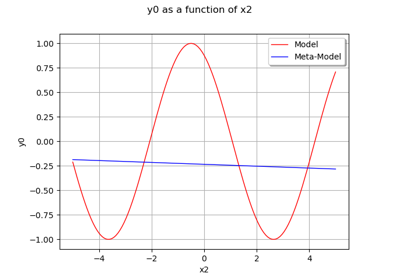GeneralLinearModelResult¶
- class GeneralLinearModelResult(*args)¶
General linear model result.
- Parameters:
- inputSample, outputSample
Sample The samples
and
.
- metaModel
Function The meta model:
, defined in :eq:metaModel.
- residuals
Point The residual errors.
- relativeErrors
Point The relative errors.
- basis
Basis Functional basis of size
:
for each
. Its size should be equal to zero if the trend is not estimated.
- trendCoefsequence of float
The trend coefficients vectors
stored as a Point.
- covarianceModel
CovarianceModel Covariance function of the Gaussian process with its optimized parameters.
- optimalLogLikelihoodfloat
The maximum log-likelihood corresponding to the model.
- inputSample, outputSample
Methods
getBasis()Accessor to the functional basis.
Accessor to the object's name.
Accessor to the covariance model.
Accessor to the input sample.
Accessor to the metamodel.
getName()Accessor to the object's name.
getNoise()Accessor to the Gaussian process.
Accessor to the optimal log-likelihood of the model.
Accessor to the output sample.
Accessor to the relative errors.
Accessor to the residuals.
Accessor to the trend coefficients.
hasName()Test if the object is named.
setInputSample(sampleX)Accessor to the input sample.
setMetaModel(metaModel)Accessor to the metamodel.
setName(name)Accessor to the object's name.
setOutputSample(sampleY)Accessor to the output sample.
setRelativeErrors(relativeErrors)Accessor to the relative errors.
setResiduals(residuals)Accessor to the residuals.
Notes
The structure is usually created by the method run() of a
GeneralLinearModelAlgorithm, and obtained thanks to the getResult() method.The meta model
is defined by:
(1)¶
where
and
are the trend functions (the
marginal of varphi(x)).
(2)¶
Examples
Create the model
and the samples:
>>> import openturns as ot >>> f = ot.SymbolicFunction(['x'], ['x * sin(x)']) >>> sampleX = [[1.0], [2.0], [3.0], [4.0], [5.0], [6.0]] >>> sampleY = f(sampleX)
Create the algorithm:
>>> basis = ot.Basis([ot.SymbolicFunction(['x'], ['x']), ot.SymbolicFunction(['x'], ['x^2'])]) >>> covarianceModel = ot.GeneralizedExponential([2.0], 2.0) >>> algo = ot.GeneralLinearModelAlgorithm(sampleX, sampleY, covarianceModel, basis) >>> algo.run()
Get the result:
>>> result = algo.getResult()
Get the meta model:
>>> metaModel = result.getMetaModel() >>> graph = metaModel.draw(0.0, 7.0) >>> cloud = ot.Cloud(sampleX, sampleY) >>> cloud.setPointStyle('fcircle') >>> graph = ot.Graph() >>> graph.add(cloud) >>> graph.add(f.draw(0.0, 7.0))
- __init__(*args)¶
- getBasis()¶
Accessor to the functional basis.
- Returns:
- basis
Basis Functional basis of size
:
for each
.
- basis
Notes
If the trend is not estimated, the collection is empty.
- getClassName()¶
Accessor to the object’s name.
- Returns:
- class_namestr
The object class name (object.__class__.__name__).
- getCovarianceModel()¶
Accessor to the covariance model.
- Returns:
- covModel
CovarianceModel The covariance model of the Gaussian process W.
- covModel
- getName()¶
Accessor to the object’s name.
- Returns:
- namestr
The name of the object.
- getNoise()¶
Accessor to the Gaussian process.
- Returns:
- process
Process Returns the Gaussian process
with the optimized parameters.
- process
- getOptimalLogLikelihood()¶
Accessor to the optimal log-likelihood of the model.
- Returns:
- optimalLogLikelihoodfloat
The value of the log-likelihood corresponding to the model.
- getRelativeErrors()¶
Accessor to the relative errors.
- Returns:
- relativeErrors
Point The relative errors defined as follows for each output of the model:
with
the vector of the
model’s values
and
the metamodel’s values.
- relativeErrors
- getResiduals()¶
Accessor to the residuals.
- Returns:
- residuals
Point The residual values defined as follows for each output of the model:
with
the
model’s values and
the metamodel’s values.
- residuals
- getTrendCoefficients()¶
Accessor to the trend coefficients.
- Returns:
- trendCoef
Point The trend coefficients vectors
stored as a Point.
- trendCoef
- hasName()¶
Test if the object is named.
- Returns:
- hasNamebool
True if the name is not empty.
- setInputSample(sampleX)¶
Accessor to the input sample.
- Parameters:
- inputSample
Sample The input sample.
- inputSample
- setName(name)¶
Accessor to the object’s name.
- Parameters:
- namestr
The name of the object.
- setOutputSample(sampleY)¶
Accessor to the output sample.
- Parameters:
- outputSample
Sample The output sample.
- outputSample
- setRelativeErrors(relativeErrors)¶
Accessor to the relative errors.
- Parameters:
- relativeErrorssequence of float
The relative errors defined as follows for each output of the model:
with
the vector of the
model’s values
and
the metamodel’s values.
- setResiduals(residuals)¶
Accessor to the residuals.
- Parameters:
- residualssequence of float
The residual values defined as follows for each output of the model:
with
the
model’s values and
the metamodel’s values.
 OpenTURNS
OpenTURNS
